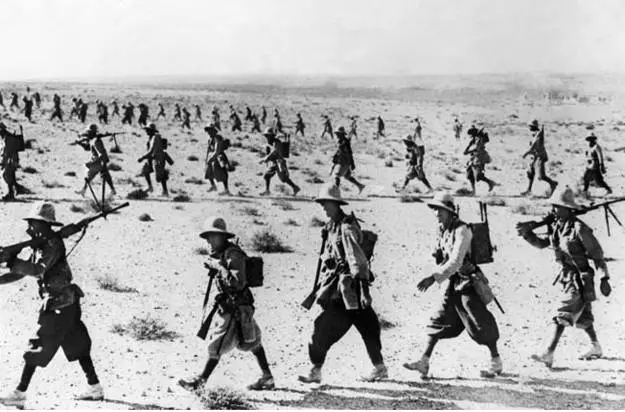The Italian advance into Egyptian territory in 1940 marked the started of the North African campaign. The offensive was ill prepared, and the consequences soon materialized
Context
After the fall of France, the war seemed to be near the end, at least in the minds of Axis leadership and especially of Benito Mussolini. The idea of an attack against Egypt from the Italian colony of Libya started to take shape in the Supreme Command, fuelled by Mussolini’s infinite ambitions. Marshall Italo Balbo, governor of Libya and superior commander for the North African theatre, was well aware of the deficiencies in equipment and training that his forces experienced. He urged the supreme command to send machine guns, tanks, artilleries and, most importantly, trucks. Balbo died on the 28th of June, crushing with his pane, shot down over Tobruk in a friendly fire accident. He was hastily replaced by Marshal Rodolfo Graziani, a veteran of Italian colonial wars who took over the task of planning the attack on Egypt. Graziani quickly realized the same issues that Balbo faced and forwarded new requests for supplies and reinforcements. Mussolini renews his pressures for an attack and, in early July, he urged Marshal Graziani to act. This attack was just a political move that, in Mussolini’s calculations, would have increased Italy’s prestige (and claims) during the peace talks (believed to be imminent). He recklessly disregarded most of Graziani’s requests, who was requesting more anti-tank weapons, tanks and trucks. Graziani tried to delay the operation as much as he could but was never determined to confront the Duce with the reality on the ground and oppose the attack, fearing to be sacked by the Dictator.
OOB of Italian forces
In summer 1940 the Italian Army had two large units deployed in Libya, the 5th Army in Tripolitania (western Libya) and the 10th Army in Cyrenaica (Eastern Libya). After the fall of France, the 10th Army became the natural choice for the upcoming offensive. It consisted of
– XXI corps, Division Cirene and Catanzaro plus the “raggruppamento Maletti”, a motorized-armoured group
– XXII Corps, Division Sirte
– XXIII Corps, Division Marmarica, 1st and 2nd black shirts division (transferred from the 5th Army)
– Libyan divisions group, formed by the 4th black shirt division and the 1st and 2nd Libyan division
The 10th Army, led by General Mario Berti, could also count on various artillery units, four battalions of L3 tankettes and the Special armoured brigade. In total, around 120.000 men, 70 M11/39 tanks (arrived in July) and a few hundred L3 tankettes. The 10th Army was a formation capable of garrisoning and defending the Italian colony, it was surely not suited for mobile warfare, with few tanks, barely 3000 operational trucks, almost no armoured cars, recon vehicles and no Bersaglieri.
The advance to Sidi El-Barrani
Following Mussolini’s continuous change of mood and ideas, the attack, originally planned for mid-July, was postponed to September. In fact, during late July and August, Mussolini attempted to mount an attack against Greece and Yugoslavia. He was blocked by the Germans, who did not want to spark any conflicts in the Balkan region. At the end of August, Mussolini’s focus shifted once mare to Egypt and urged Graziani to attack, despite the Marshall’s request to wait for the arrival of more trucks. It is important to remember that, at the time, the Italians believed that a German landing in England was imminent (this was what the Germans told their allies) thus, Mussolini wanted to have his share of “glory” before the end of the war. The Duce issued his ultimatum and Graziani reluctantly launched his forces forward against the Commonwealth positions.

Italian infantry advancing in the desert
On the 9th of September, aware of the lack of mobility of his troops, and fearing for their fragility, Graziani decided to advance in a unique mass column along the coastline that could oppose enemy counterattacks with the force of numbers. The Libyan divisions and Maletti’s mobile group advanced at the front, followed by the XXIII corps and all other units in the third line. On the 13th of September, the 10th army entered Egypt and occupied Sidi El Barrani on the 16th. Graziani called for a halt and deployed his forward forces in entrenched strongpoints surrounding Sidi-El-Barrani in a kind of triangular perimeter. The Libyan divisions and Maletti’s group formed the eastern side while the Cirene division held the most southern point and the Catanzaro and one Black shirt division closer to Sidi El Barrani. General Bergonzoli’s XXIII Corps was stationed in Sollum while the Special armoured brigade of General Babini was far behind in Cyrenaica due to the lack of sufficient transport carriages for the medium tanks. The logistics of the 10th army had reached their limits and more supplies, trucks and weapons were needed to attack the Marsa Matruh line where the Commonwealth forces had withdrawn to wait for the Italians. During the advance, a few shots had been fired between the Italians and the British rear guards.
The Italian advance to Sidi el Barrani kick-started the North African campaign of WW2, the British and the Italians dug in and waited for the opponent to make a move. This will occur in December when the Commonwealth forces launched Operation Compass.
Sources
Montanari, M. (1990). Le operazioni in Africa Settentronale, Volume I: Sidi El Barrani. Ufficio storico SME.
Santangelo, A. (2012). Operazione Compass: La caporetto del deserto.